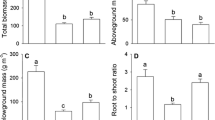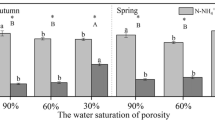Abstract
Algal N labelled with 15N added to a flooded soil in laboratory columns without plants was studied to determine the changes over time in the fate of N assimilated by algae and to study how its fate is affected by (a) exclusion of light simulating complete closure of the rice canopy, and (b) addition of fertilizer-NH4 *. In the light but with no added fertilizer-N there was little net mineralization of the added algal N during the first 4 weeks, but after 8 weeks 42% had been mineralized, of which 95% was denitrified. Exclusion of light caused net mineralization to proceed more rapidly in the first 4 weeks due to the death of algal cells and lowered reassimilation. After 8 weeks 51% had been mineralized, of which 54% was denitrified, 16% volatilized and 30% was present as KCl exchangeable NH4 +-N. Application of fertilizer-NH4 + apparently caused mineralization of 25% of the algal N within one week but the results were probably affected by pool substitution in which labelled N mineralized to NH4 +-N was diluted with fertilizer – NH+ 4 and then immobilized leaving more labelled NH4–N in the mineral pool. After 8 weeks, 42% of algal N had been mineralized, of which 69% was estimated to have been denitrified, 19% lost through NH3 volatilization and 12% remained as extracted NH4 ++NO- 3. Uptake of N by a rice crop would reduce the gaseous losses. Algal N was mineralized quickly enough to be available during the growing season of a rice crop and, depending on field conditions, algae may have a role in assimilating N and protecting it from loss as well as being a major driving force for NH3 volatilization through diurnal increases in pH.
Similar content being viewed by others
References
Bowmer KH & Muirhead WA (1987) Inhibition of algal photosynthesis to control pH and reduce ammonia volatilization from flooded rice. Fertil Res 13: 13–29.
Bremner JM (1965) Total nitrogen In: Black CA (ed) Methods of Soil Analysis: Part 2 1 (ed. C A Black). Madison: American Society of Agronomy Monograph 9: 149–1176.
Buresh RJ Austin, ER & Craswell ET (1982) Analytical methods in 15N research. Fertil Res 3: 37–62.
Craswell ET, De Datta SK, Weeraratne CS & Vlek PLG (1985) Fate and efficiency of nitrogen fertilizers applied to wetland rice I. The Philippines. Fertil Res 6: 49–63.
Fillery IRP, Simpson JR & De Datta SK (1984) Influence of field environment and fertilizer management on ammonia loss from flooded rice. Soil Sci Soc Am J 48: 914–920.
Fillery IRP, Roger PA & De Datta SK (1986) Ammonia volatilization from N sources applied to rice fields: II. Floodwater properties and submerged photosynthetic biomass. Soil Sci Soc Am J 50: 88–91.
Grant IF & Seegers R (1985) Tubificid role in soil mineralization and recovery of algal nitrogen by lowland rice. Soil Biol Biochem. 17: 559–563.
Hewitt EJ (1996) Sand and Water Culture Methods Used in the Study of Plant Nutrition. Farnham Royal: Commonwealth Agricultural Bureaux.
IRRI (1989) Rice Facts 1988 (Revised in June 1989) Los Banos, Laguna, Philippines: International Rice Research Institute
Jarvis RA (1968) Soil Survey of the Reading District. Harpenden: Soil Survey of England and Wales.
Jewell WJ (1971) Aquatic weed decay: dissolved oxygen utilization and nitrogen and phosphorus regeration. J Water Poll Cont Feder 43: 1457–1467.
Kistritz RU (1978) Recycling of nutrients in an enclosed aquatic community of decomposing macrophytes (Myriophyllum spicatum) OIKOS 30: 561–569.
Meyer ML, Bloom PR & Grava J 1989 Transformations and losses of applied N-15 labelled ammonium in a flooded organic soil. Soil Sci Soc Am J 53: 79–85.
Mikkelsen DS, De Datta SK & Obcemea WN (1978) Ammonia volatilization losses from flooded rice soils. Soil Sci Soc Am J 42: 725–730.
Powlson DS & Barraclough D (1993) Mineralization and assimilation in soil-plant systems. In: Knowles R & Blackburn T H (eds) Nitrogen Isotope Techniques pp 209–242. San Diego: Academic Press
Roger PA (1986) Effect of algae and aquatic macrophytes on nitrogen dynamics in wetland rice fields. Transactions of the 13th Congress of the International Society of Soil Science, Hamburg: 783–793.
Simpson JR, Muirhead WA, Bowmer KH, Cai GX & Freney JR (1988) Control of gaseous nitrogen losses from urea applied to flooded rice soils. Fertil Res 18: 31–47.
Thind HS (1991) Studies on the role of floodwater algae and green manure on the transformations of 15N-urea applied to floodwater under lowland rice condition. PhD thesis, University of Reading.
Tirol A, Roger PA & Watanabe I (1982) Fate of nitrogen from blue-green algae in a flooded rice soil. Soil Sci Plant Nutr 28: 559–569.
Vlek PLG, Stumpe JM & Byrnes BH (1980) Urease activity and inhibition in flooded soil systems. Fertil Res 1: 191–202.
Wilson JT, Eskew DL & Babte M (1980) Recovery of nitrogen by rice from blue green algae added in a flooded soil. Soil Sci Soc Am J 44: 1330–1331.




